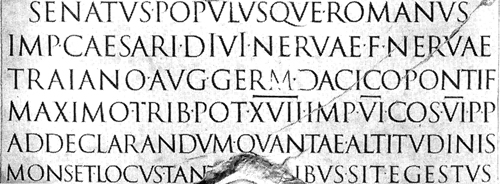an entirely new concept
“This year we, of course, have an entirely new concept. We have been working on it for just months and months now, and we are extremely proud of it, because it is so highly innovative. Are you ready? Here it is:
Gray.
Eveybody got that? Better write it down! If we find any ladies out on the street without their gray on, we are going to be very upset. Also we are asking you to purchase certain mandatory accessories in the form of several thousand dollars worth of handbags, shoes, belts, and watch straps made from dead crocodiles. NO, YOU MAY NOT ASK WHY! JUST DO IT!”
—Dave Barry, Revenge of the Pork Person, from Dave Barry’s Greatest HIts, 1988.
I am the urn of Tita Vendia

—David Sacks, Letter Perfect, 2003.
The most beautiful lettering in the world

“The most beautiful lettering in the world is often said to be found in
this marble-carved inscription of A.D. 113, which survives, although
damaged, on the large pedestal of Trajan’s Column in Rome.”
—David Sacks, Letter Perfect, 2003.
[T]he medieval i
“[T]he medieval i originally had no dot but acquired one because the letter as a hatless stroke was hard to distinguish on a crowded page of handwriting. By about A.D. 1000 the custom had arisen of perhaps topping the minuscule letter with a slanted mark, at the writer’s discretion: ´. With the spread of printing in the late 1400s, the stroke was generally reduced to an economical dot i . . . although the stroke still shows up today in cursive-print wedding invitations and similar. The i’s dot, meanwhile, has become proverbial for any small detail. . . .”
—David Sacks, Letter Perfect, 2003.
Iesus Nazarenus
“At Jesus’ execution, the Roman letters INRI formed the initials of a
sarcastic Latin title: Iesus Nazarenus Rex Iudaeorum, ‘Jesus of Nazareth, King of the
Jews.’. . .
Julius Caesar was actually named Iulius (Yoolius). The emperor Trajan was Traianus (Trah-yahn-us). . . . Whatever future claim the letter J might have on these words in English, they began in Latin with rather different sounds and spellings. . . .”
—David Sacks, Letter Perfect, 2003.
IVLIVS CAESAR and MARCVS AVRELIVS
“Back when Julius Caesar or Marcus Aurelius ruled Rome, U’s shape was sharper, more svelte. In fact U looked exactly like her future daughter V (without V’s sound). Thus, in Roman stone-carved inscriptions, the above-mentioned emperors’ names would appear as IVLIVS CAESAR and MARCVS AVRELIVS.”
—David Sacks, Letter Perfect, 2003.
A Chorale* of Cherokee Night Music As Heard through an Open Window In Summer Long Ago

carolina chickadee / katydid / crow / wolf / Beatles / turkey / goose /
bullfrog / spring frog
—Jonathan Williams, from Blues Roots & Rue Bluets; A Garland for the Southern Appalachians, 1985.
A flat toothpick
“A box of . . . Ideal toothpicks from the mid-1960s carries on its bottom this telegraphic legend: ‘The only Toothpick tapered thin—polished—removes food particles from between closely set teeth.’ A flat toothpick bought today is likely to have been stamped out of veneer that has not first been beveled or skived. The result is a thin little stick with blunt ends that hardly deserves the name toothpick. It is typically very ineffective for fine picking, though it may still serve for chewing.”
—Henry Petroski, The Toothpick; Technology and Culture, 2007.
Diamond quality
“A box of Diamond Brand ‘double pointed-tapered-flat polished white birch’ toothpicks from abou the 1960s claimed to contain ‘the most perfect toothpick made.’ The toothpick’s quality . . . was touted on every panel, including the bottom, which bragged that the product was ‘made in U.S.A. by American workers of American materials.’ The bottom of the box said also of the Diamond trademark on the top that ‘its use on a package of wood products insures Diamond quality of both materials and workmanship—Every One Perfect.’”
—Henry Petroski, The Toothpick; Technology and Culture, 2007.
three million toothpicks
“With or without promotions by the industry, adults have developed hobbies, if not obsessions, involving the construction out of toothpicks and glue of replicas of everything from a crucified Christ to the Titanic and other historic steamships. . . . The Christ, which was made up of 65,000 sandwich, flat, square, and round toothpicks, took 2,500 hours of work to glue into place. The rock guitarist Wayne Kusy used 194,000 toothpicks to make a sixteen-foot-long replica of the Lusitania. . . .
Stephen Backman, who took two and a half years to craft a thirteen-foot replica of the Golden Gate Bridge out of thirty thousand toothpicks, describes himself as an ‘artist working in toothpicks.’. . . Another sculptor, Michael A. Smith, of Baton Rouge, Louisiana, produced a fifteen-foot-long, 850-pound alligator by gluing together about three million toothpicks, which took him about three years.”
—Henry Petroski, The Toothpick; Technology and Culture, 2007.